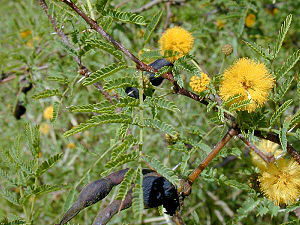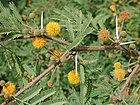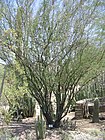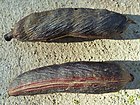Note: This is a project under development. The articles on this wiki are just being initiated and broadly incomplete. You can Help creating new pages.
Difference between revisions of "Acacia farnesiana - Vitkhadira"
(→References) |
(→Common names) |
||
| (5 intermediate revisions by the same user not shown) | |||
| Line 1: | Line 1: | ||
[[File:Acaciafarnesiana1web.jpg|thumb|right|''Vitkhadira'', ''Acacia farnesiana'']] | [[File:Acaciafarnesiana1web.jpg|thumb|right|''Vitkhadira'', ''Acacia farnesiana'']] | ||
| − | '''Vitkhadira''' is a shrub which usually grows to a height of around 1 to 1.5 metres. Almost every part of the plant contains sharp thorns. | + | '''Vitkhadira''' is a shrub which usually grows to a height of around 1 to 1.5 metres. Almost every part of the plant contains sharp thorns. It is a multipurpose tree with a wide range of uses as a food, medicine, perfume and source of materials. This plant is belongs to Memosaceae family.<ref name="Plant family"/> |
| − | |||
==Uses== | ==Uses== | ||
| − | {{Uses|Oral problems}}, {{Uses|Diarrhea}}, {{Uses|Inflammation}}, {{Uses|Cough}}, {{Uses|Itching}}, {{Uses|Urinary tract disorders}}. | + | {{Uses|Oral problems}}, {{Uses|Diarrhea}}, {{Uses|Inflammation}}, {{Uses|Cough}}, {{Uses|Itching}}, {{Uses|Urinary tract disorders}}.<ref name="Uses"/> |
| − | <ref name="Uses"/> | ||
==Parts Used== | ==Parts Used== | ||
| − | {{Parts Used|Stem}}, {{Parts Used|Bark}}, {{Parts Used|Heartwood}} | + | {{Parts Used|Stem}}, {{Parts Used|Bark}}, {{Parts Used|Heartwood}}. |
==Chemical Composition== | ==Chemical Composition== | ||
| Line 14: | Line 12: | ||
==Common names== | ==Common names== | ||
| − | {{Common names|kn=Byadala gida, Jaali | + | {{Common names|kn=Byadala gida, Kasturi Jaali|sa=Arimedah, Godhaskanda, Kalaskandha, Vitkhadir|ta=Arimetam, Kacappuppivelamaram, Kasturivel, Kirimetam, Peyvel|te=Arimidamu, Kampu tumma, Kasthoori thumma, Murikitumma, Piyyathumma|hi=Durgandhakhair, Gandhi-babul, Guhbabul, Pissibabul|en=Cassie}} |
<ref name="Common names"/> | <ref name="Common names"/> | ||
| Line 38: | Line 36: | ||
==Identification== | ==Identification== | ||
===Leaf=== | ===Leaf=== | ||
| − | {{Leaf|Bipinnate| | + | {{Leaf|Bipinnate|Alternate|Leaves ca. 5 in a cluster, 2-7 cm; pinnae 5 pairs, 1-2.5 cm; leaflets 10-15 pairs, elliptic, 5 x 1 mm, overlapping, glabrous, base truncate, margin entire, apex obtuse}}<ref name="Leaf"/> |
===Flower=== | ===Flower=== | ||
| − | {{Flower|Bisexual| | + | {{Flower|Bisexual|Axillary globose heads|Yellow|Many|Flower-heads globose, 8 mm across, 2 or 3 in axillary cluster, to 2 cm. }} |
===Fruit=== | ===Fruit=== | ||
| − | {{Fruit|A Pod|5 x 0.5 cm| | + | {{Fruit|A Pod|5 x 0.5 cm|Pulpy, turgid, glabrous, obtuse at apices, horned||Seeds 20 or more, globose, 0.5 mm, 2-seriate.}} |
===Other features=== | ===Other features=== | ||
| Line 72: | Line 70: | ||
==References== | ==References== | ||
| − | |||
<references> | <references> | ||
<ref name="Uses">[https://easyayurveda.com/2016/05/04/irimeda-arimeda-acacia-farnesiana/ Uses]</ref> | <ref name="Uses">[https://easyayurveda.com/2016/05/04/irimeda-arimeda-acacia-farnesiana/ Uses]</ref> | ||
<ref name="Chemical composition">[http://gbpihedenvis.nic.in/PDFs/Glossary_Medicinal_Plants_Springer.pdf Chemical composition]</ref> | <ref name="Chemical composition">[http://gbpihedenvis.nic.in/PDFs/Glossary_Medicinal_Plants_Springer.pdf Chemical composition]</ref> | ||
| − | |||
<ref name="Leaf">[http://keralaplants.in/ Botanic description]</ref> | <ref name="Leaf">[http://keralaplants.in/ Botanic description]</ref> | ||
<ref name="Common names">[http://envis.frlht.org/bot_search Vernacular names]</ref> | <ref name="Common names">[http://envis.frlht.org/bot_search Vernacular names]</ref> | ||
| − | + | <ref name="Plant family">Karnataka Aushadhiya Sasyagalu By Dr.Maagadi R Gurudeva, Page no:81</ref> | |
| − | |||
</references> | </references> | ||
Latest revision as of 16:11, 6 January 2022
Vitkhadira is a shrub which usually grows to a height of around 1 to 1.5 metres. Almost every part of the plant contains sharp thorns. It is a multipurpose tree with a wide range of uses as a food, medicine, perfume and source of materials. This plant is belongs to Memosaceae family.[1]
Contents
- 1 Uses
- 2 Parts Used
- 3 Chemical Composition
- 4 Common names
- 5 Properties
- 6 Habit
- 7 Identification
- 8 List of Ayurvedic medicine in which the herb is used
- 9 Where to get the saplings
- 10 Mode of Propagation
- 11 How to plant/cultivate
- 12 Commonly seen growing in areas
- 13 Photo Gallery
- 14 References
- 15 External Links
Uses
Oral problems, Diarrhea, Inflammation, Cough, Itching, Urinary tract disorders.[2]
Parts Used
Chemical Composition
Ripe pods contain tannins and several polyphenolic compounds. Essential oil from pods. [3]
Common names
| Language | Common name |
|---|---|
| Kannada | Byadala gida, Kasturi Jaali |
| Hindi | Durgandhakhair, Gandhi-babul, Guhbabul, Pissibabul |
| Malayalam | NA |
| Tamil | Arimetam, Kacappuppivelamaram, Kasturivel, Kirimetam, Peyvel |
| Telugu | Arimidamu, Kampu tumma, Kasthoori thumma, Murikitumma, Piyyathumma |
| Marathi | NA |
| Gujarathi | NA |
| Punjabi | NA |
| Kashmiri | NA |
| Sanskrit | Arimedah, Godhaskanda, Kalaskandha, Vitkhadir |
| English | Cassie |
Properties
Reference: Dravya - Substance, Rasa - Taste, Guna - Qualities, Veerya - Potency, Vipaka - Post-digesion effect, Karma - Pharmacological activity, Prabhava - Therepeutics.
Dravya
Rasa
Tikta (Bitter), Kashaya (Astringent)
Guna
Laghu (Light), Rooksha (Dry)
Veerya
Sheeta (cold)
Vipaka
Katu (Pungent)
Karma
Pitta, Kapha
Prabhava
Habit
Identification
Leaf
| Kind | Shape | Feature |
|---|---|---|
| Bipinnate | Alternate | Leaves ca. 5 in a cluster, 2-7 cm; pinnae 5 pairs, 1-2.5 cm; leaflets 10-15 pairs, elliptic, 5 x 1 mm, overlapping, glabrous, base truncate, margin entire, apex obtuse |
Flower
| Type | Size | Color and composition | Stamen | More information |
|---|---|---|---|---|
| Bisexual | Axillary globose heads | Yellow | Many | Flower-heads globose, 8 mm across, 2 or 3 in axillary cluster, to 2 cm. |
Fruit
| Type | Size | Mass | Appearance | Seeds | More information |
|---|---|---|---|---|---|
| A Pod | 5 x 0.5 cm | Pulpy, turgid, glabrous, obtuse at apices, horned | Seeds 20 or more, globose, 0.5 mm, 2-seriate. | {{{6}}} |
Other features
List of Ayurvedic medicine in which the herb is used
Where to get the saplings
Mode of Propagation
How to plant/cultivate
Seeds germinate readily. For faster germination, they may be scarified and soaked in water overnight before sowing.
Commonly seen growing in areas
Tropical area, Sub tropical areas.
Photo Gallery
References
- ↑ Karnataka Aushadhiya Sasyagalu By Dr.Maagadi R Gurudeva, Page no:81
- ↑ Uses
- ↑ Chemical composition
- ↑ Vernacular names
- ↑ Botanic description
External Links
- Ayurvedic Herbs known to be helpful to treat Oral problems
- Ayurvedic Herbs known to be helpful to treat Diarrhea
- Ayurvedic Herbs known to be helpful to treat Inflammation
- Ayurvedic Herbs known to be helpful to treat Cough
- Ayurvedic Herbs known to be helpful to treat Itching
- Ayurvedic Herbs known to be helpful to treat Urinary tract disorders
- Herbs with Stem used in medicine
- Herbs with Bark used in medicine
- Herbs with Heartwood used in medicine
- Herbs with common name in Kannada
- Herbs with common name in Hindi
- Herbs with common name in Tamil
- Herbs with common name in Telugu
- Herbs with common name in Sanskrit
- Herbs with common name in English
- Habit - Shrub or small tree
- Index of Plants which can be propagated by Seeds
- Index of Plants which can be propagated by Cuttings
- Herbs that are commonly seen in the region of Tropical area
- Herbs that are commonly seen in the region of Sub tropical areas
- Herbs
- Shrub
- Fabaceae




